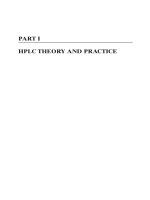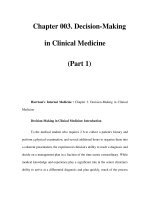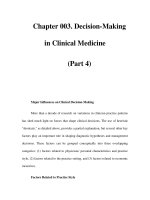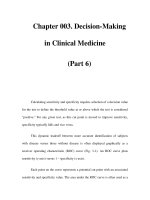Chapter 117. Health Advice for International Travel (Part 1) doc
Bạn đang xem bản rút gọn của tài liệu. Xem và tải ngay bản đầy đủ của tài liệu tại đây (41.92 KB, 5 trang )
Chapter 117. Health Advice for
International Travel
(Part 1)
Harrison's Internal Medicine > Chapter 117. Health Advice for
International Travel
Health Advice for International Travel: Introduction
According to the World Tourism Organization, the number of international
tourist arrivals in 2004 reached an all-time record of 763 million. This number
represents an increase over the 2003 figure of almost 11%—the highest and the
only double-digit percentage increase since 1980, when these statistics were first
collected. Not only are more people traveling; travelers are seeking more exotic
and remote destinations.
Studies show that 50–75% of short-term travelers to the tropics or
subtropics report some health impairment. Most of these health problems are
minor: only 5% require medical attention, and <1% require hospitalization.
Although infectious agents contribute substantially to morbidity among travelers,
these pathogens account for only ~1% of deaths in this population. Cardiovascular
disease and injuries are the most frequent causes of death among travelers from
the United States, accounting for 49% and 22% of deaths, respectively.
Age-specific rates of death due to cardiovascular disease are similar among
travelers and nontravelers. In contrast, rates of death due to injury (the majority
from motor vehicle, drowning, or aircraft accidents) are several times higher
among travelers. Figure 117-1 summarizes the monthly incidence of health
problems during travel in developing countries.
Figure 117-1
Incidence rate, per month, of health problems during a stay in
developing countries.
PCV, Peace Corps volunteer.
(From Steffen R, Lobel HO: Epidemiologic
basis for the
practice of travel medicine. J Wilderness Med 5:56, 1994. Reprinted
with permission from Chapman and Hall, New York.)
General Advice
Health maintenance recommendations are based not only on the traveler's
destination but also on assessment of risk, which is determined by health status,
specific itinerary, and lifestyle during travel. Detailed information regarding
country-specific risks and recommendations may be obtained from the Centers for
Disease Control and Prevention (CDC) publication Health Information for
International Travel (available at
Fitness for travel is an issue of growing concern in view of the increased
numbers of elderly and chronically ill individuals journeying to exotic destinations
(see "Travel and Special Hosts," below). Since most commercial aircraft are
pressurized to 2500 m (8000 ft) above sea level (corresponding to a Pa
O2
of ~55
mmHg), individuals with serious cardiopulmonary problems or anemia should be
evaluated before travel. In addition, those who have recently had surgery, a
myocardial infarction, a cerebrovascular accident, or a deep-vein thrombosis may
be at high risk for adverse events during flight. A summary of current
recommendations regarding fitness to fly has been published by the Aerospace
Medical Association Air Transport Medicine Committee
(www.asma.org/publications/). A pretravel health assessment may be advisable for
individuals considering particularly adventurous recreational activities, such as
mountain climbing and scuba diving.









